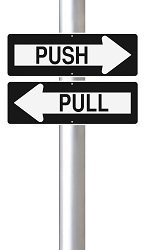
Something Will Change, Eventually!
Originally due last October, the Federal Reserve released its latest payment report, Strategies for Improving the U.S. Payment System this week, which finds that while there may be broad consensus that the U.S. payment system should be improved, that consensus has yet to consolidate into demand for any particular solution.
The paper summarizes input from businesses and other interested parties solicited from a Consultation Paper released in September 2013 and collected through the www.FedPaymentsImprovement.org site created for that purpose as well as in town hall meetings and interviews.
“There is more common ground and shared vision than was previously thought to exist,” the Fed reports. “We believe these developments illustrate a rare confluence of factors that create favorable conditions for change.”
The Need for Speed?
 Since “there is currently no ubiquitous, convenient and cost-effective way for U.S. consumers and businesses to make (near) real-time payments from any bank account to any other bank account,” the Fed believes that having this capability “will greatly improve the U.S. payment system and help maintain its global competitiveness.”
Since “there is currently no ubiquitous, convenient and cost-effective way for U.S. consumers and businesses to make (near) real-time payments from any bank account to any other bank account,” the Fed believes that having this capability “will greatly improve the U.S. payment system and help maintain its global competitiveness.”
Business owners have a different perspective, however, and told the Fed that “real-time payments should be pursued only if a clear business case exists,” which they apparently feel does not.
Most business owners thought that data security sits far higher on the list of priorities, but since the Federal Reserve can’t really help effect that, they wisely concluded that “stakeholders must do their part to achieve this desired outcome; it will not be achieved solely through Federal Reserve actions.”
The real problem seems to be a Catch-22: businesses won’t change their practices until they perceive such wide-spread adoption that they know they’re implementing something of proven utility, but there’s so much innovation and choice in the payments space right now it is “creating confusion” that prevents anything from moving into a clear lead.
Push or Pull?
 The Fed set out to help with this by at least generating consensus on one of the most fundamental aspects of making a payment: who gives account information to whom?
The Fed set out to help with this by at least generating consensus on one of the most fundamental aspects of making a payment: who gives account information to whom?
When the person making a payment must hand over his account information to the person he is paying, it’s known as a “debit-pull” payment – an example is the auto-pay option you might have for your phone bill. You don’t know the phone company’s account information, but they know yours – a situation that 85% of consumers and 81% of businesses do not like.
“Credit-push” payments are just the opposite: the person receiving funds is the one who hands over his account information.
The Fed determined that whatever payment solutions become ubiquitous, the business consensus clearly indicates that they “should use a credit-push, rather than a debit-pull method.”
Besides the obvious privacy benefits, the Fed also concluded that “credit-push systems allow the paying bank to authenticate the customer and confirm ‘good funds’ are available to support the transaction, creating a more predictable payment cycle...”
Why Don’t You Go First?
And while that knowledge certainly helps, it doesn’t really address the main impediment to wide-spread adoption of any particular methodology.
The biggest problem is that more than two thirds of businesses agree that they won’t implement a new payment process until after it is used and accepted by most people and businesses.
If the majority won’t move until it sees that the majority has already moved, we might be in for a protracted period of stasis. Seeing this, the report discussed what the Fed would do about payments over the next decade. Quite logically, their first strategy is to continue asking businesses what they want.
And since they don’t have the authority – or even the slightest desire – to try to force adoption of any particular method, they aim to become a leader and idea clearinghouse. Fortunately they add, “as a practical matter, the Federal Reserve believes it is preferable to pursue non-regulatory/non-legislative tactics in support of this strategy, whenever possible.”
And Why Are We Doing This?
 If the point is to create “ubiquitous, convenient and cost-effective” ways for people to transfer money from one account to another, we have to wonder at the way the report regards paper checks.
If the point is to create “ubiquitous, convenient and cost-effective” ways for people to transfer money from one account to another, we have to wonder at the way the report regards paper checks.
“Among large businesses,” they report, “checks represent more than half of payments sent and received; among small and micro businesses, these percentages are more than 70 percent and 90 percent, respectively.”
Immediately after acknowledging that “billions of paper checks continue to be written by businesses each year,” and that practically all of them are digitized the moment they’re accepted, they go on to discuss the problem of “adopting” electronic payments in their stead:
1) electronic payments are more complex to implement than checks;
2) virtually all businesses can issue or receive checks but electronic payment capabilities are not ubiquitous;
3) small- and medium-size businesses often find it difficult to obtain support from their financial institutions to implement electronic payments;
4) it’s difficult for payers to easily find, manage and use the electronic payment identity of their payees; and
5) it’s difficult to exchange payment-related information electronically (e.g., invoices).
“The Federal Reserve believes,” the report concludes, “that enhancements to electronic alternatives to the paper check are needed” before businesses will stop using them.
We’re obviously biased, but it seems that there are more disadvantages than advantages to some of these new methods. No one wants to hamper progress, but as the Fed writes, “business-to-business check writing remains entrenched, especially among smaller businesses,” and the reason is simple supply and demand.
Here’s the demand: No electronic payment method competes with the simplicity, the irrefutable intent to pay, or the rock-solid security of a handwritten check.
And here’s the supply: With the right equipment the paper check becomes a digital entity the moment you scan it; with the right service the digital version can be deposited into your account immediately (without telling your customer your routing or account number); and it’s even possible to have a third party guarantee the revenue the check represents, if you comply with certain terms.
Even the Fed thinks that it may be a while – a decade? – before that equation changes. Click here to learn how to safely and effectively guarantee payments by check today.



